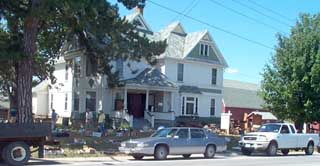
homestead sold at auction One could imagine that the Bible that Eunice Wilcox Ely now owns has witnessed it all - the travels, the hard work, the marriages, births and deaths that make up the story of a family. That Bible, along with lots of other household items, tools, furnishings, knick knacks and even the historic Bergen home, barns and outbuildings that held them all, was auctioned in late August. The huge old farmhouse and surrounding five acres, located at 90 South Lake Avenue, was built when Bergen was just becoming a community. Also sold in the auction was the house across the street at 79 South Lake Avenue, which once was a tenant house for those who helped on the farm. When Able Wilcox's brother settled here, he wrote home to Connecticut that there was "hardly a stone to turn" in the rich soil. That was enough to bring Able and other Wilcoxes to the area, said Ely. Able E. Wilcox, Ely's great-great-grandfather, came to own all of the property that today makes up the four corners of the intersection of Routes 19 and 33. Able was "a self-educated man and he experimented with farming methods," said Ely. "I have some letters he wrote about some things he was trying with peaches." Able and his wife had four children; each was to inherit one of the four corners of the property. In 1856, Able's daughter Ellen, called Nellie, inherited the section where Able had built the original farmhouse, said both Ely and George "Bill" Mayne III, whose father George Mayne Jr. was the last to actively farm the property. Nellie married a man named Lyndon David "L.D." Arnold and they settled into the house. After Able died in 1879, they set about to make it their own. L.D. played the violin and liked to give dances, "jigs," for his friends and neighbors, so he wanted a place big enough to dance in. In 1900, L.D. and his wife, whom he called, "Nell," built the existing house, literally wrapping the new construction around the original house. "You can see where the old floorboards end and the new house begins," said Bill Mayne. The house was built for dancing and parties, and so has more than 3500-square-feet, with a parlor and a living room, and a dining room with a fireplace, and five or six bedrooms. It still has its original siding, said Bill, and true to the maxim that they don't make 'em like they used to, is "really solid." Nellie and L. D had a daughter named Clara, born in 1877, who married George Mayne Sr., a Stafford farmer. Clara went to live with George in Stafford until after Nellie died 1915. L.D., alone in a big house, struck a deal with his daughter and son-in-law. George and Clara came home to run, and eventually inherit, the farm, and take care of L.D. until he died in 1932. The Maynes ran a "general" farm, said Bill. Hay, oats, corn, a few cows, and they dabbled in raising sheep. But their son (and Bill's father) George Mayne Jr., became well known as a fine sheep farmer. George Mayne Jr. and his family, including his wife Marion and children Bill, Claire, and Barbara Jean, lived in the tenant house across the street until 1960, when George Mayne Sr. died (Clara had died in 1959). George Mayne Jr. and his family then moved to the big house across the street, said Bill. The tenant house has been rented to various families since then. Bill remembers many dark springtime nights spent lambing. He knew he wouldn't grow up to be a farmer. He left the farm in 1977 and now lives in Greece. Marion died in 1989 and George Jr. in December 2001. They and many of their relatives, including George Sr. and Clara, are buried in Mount Rest Cemetery in Bergen. Many of their children, grandchildren and great-grandchildren are still living in Bergen and the Rochester area, but the family decided the main house, the property and the house and property across the street should be sold. Harris Wilcox Auctioneers handled the sale on August 20. Family members aren't sure what's next for the houses and barns, but both Eunice and Bill were sure to get a small piece of their family's history to save and share. Eunice has the Bible; Bill bid on and won a few of L.D.'s violins. Bergen history The Town of Bergen was part of the Triangle Tract and the 100,000 Acre Tract or the Connecticut Tract in the Morris Reserve. It was also part of the town of Northampton and Murray. In 1813, Bergen was formed from the town of Murray. Byron was part of Bergen until 1820. The Bergen area was opened up in 1801 when a road was hacked through the thick "Northwoods" from LeRoy to Lake Ontario. A colony of 60 families from the State of Connecticut settled the area from Fort Hill to the Black Creek from 1805-1810. The first store was a mile south of Route 33 on Route 19 on the east side of the road. The first group of stores was located from the intersection of Lake Road (Route 19) and Route 262 to the intersection of Route 19 and the Scottsville Road (Route 33A). This area was called Buell's Corner, later Bergen Corners or High Bergen. After the railroad came through in 1836 an area was laid out around the intersection of Lake Road (Route 19) and the railroad for businesses and houses. It was called Wardville after the Levi Ward family who laid it out. It was also called Cork, after the Irish who settled there while and after the building of the railroad. The two areas were soon connected by residences and churches. This area, along with the surrounding residences, was incorporated in 1877 as the Village of Bergen. from "A Guide to the Historic Business District of Bergen" brochure |

